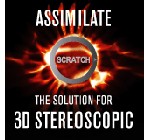Blog Archives
The new 3D is here and it’s name is Modo
Those of you  familiar with 3D animation have probably been through the arguments with colleagues about which software you prefer, Maya, 3D Studio Max, Lightwave or perhaps the very popular Cinema 4D. But a new player has arrived, one that boasts a new interface, simple and innovative controls and all the while providing the features one expects from a professional, animation program. “Just arrived…” is a bit of an understatement, in fact the software has been around for a few years now, but has only recently started to gain some real traction. Although I’ll admit first off that I haven’t had the full chance to explore all the functions and formalities of this little gem, I will say that it is steaming with features in both modeling and customizations. But the real kicker here is the learning curve and word on the street is that animation houses are testing this little program and reporting back that it’s ease of use if by far the most stream lined in the business. This is the first piece of software to come from Luxology, a company founded recently by former Lightwave 3D stalwarts Allen Hastings, Stuart Ferguson, and Brad Peebler, and they clearly have a winner on their hands. It seems they listened to both seasoned vets and newbie’s when designing this program and have come up with something that appeals to both. Stewards of the business can just right in and feel right at home, while the newcomers will not have to become insomniacs just to find out how to properly spin a cube. The one thing that is lacking with this software is creation of tutorials. No matter where you experience level is, everyone needs a good tutorial and unfortunately the lack of such documentation or video’s is a regret for the time being, that said, it does of course come with the standard documentation that we’ve come to know, but it’s simply not enough.
familiar with 3D animation have probably been through the arguments with colleagues about which software you prefer, Maya, 3D Studio Max, Lightwave or perhaps the very popular Cinema 4D. But a new player has arrived, one that boasts a new interface, simple and innovative controls and all the while providing the features one expects from a professional, animation program. “Just arrived…” is a bit of an understatement, in fact the software has been around for a few years now, but has only recently started to gain some real traction. Although I’ll admit first off that I haven’t had the full chance to explore all the functions and formalities of this little gem, I will say that it is steaming with features in both modeling and customizations. But the real kicker here is the learning curve and word on the street is that animation houses are testing this little program and reporting back that it’s ease of use if by far the most stream lined in the business. This is the first piece of software to come from Luxology, a company founded recently by former Lightwave 3D stalwarts Allen Hastings, Stuart Ferguson, and Brad Peebler, and they clearly have a winner on their hands. It seems they listened to both seasoned vets and newbie’s when designing this program and have come up with something that appeals to both. Stewards of the business can just right in and feel right at home, while the newcomers will not have to become insomniacs just to find out how to properly spin a cube. The one thing that is lacking with this software is creation of tutorials. No matter where you experience level is, everyone needs a good tutorial and unfortunately the lack of such documentation or video’s is a regret for the time being, that said, it does of course come with the standard documentation that we’ve come to know, but it’s simply not enough.
Overall it’s hard not be impressed with Modo, but I the verdict is still out on whether or not this program can make enough headway to storm the walls of Maya and other giants who have already solidified their name. Only time will tell, but I’ve included a video below for those who are curious. It’s pretty basic, just going through the general presets and showing what Modo has to offer out of the box.
‘Assimilate’ Adds New Fire With Scratch v.5.1
 SCRATCH the’ Digital Finishing Solution’ by Assimilate is billed by the company as the essential mix for a real-time, resolution-dependent data workflow.Riding the RED MX Wave and beyond: The RED-ONE Digital Camera has taken the entertainment world by storm. Assimilate’s Scratch 5.1 leads the industry with first support for RED cameras, such as support for multiple RED Rocket cards in a single SCRATCH system; first dual RED Rocket support for MX R3D; and first non-RED application to support the new RED MX sensor and revised color math, with native real-time playback and adjustment of all on-camera color parameters, such as FLUT, exposure, and curves. Working easily with the native R3D files, SCRATCH streamlines the RED ONE MX workflow and delivers a high-quality master for multiple delivery formats.
SCRATCH the’ Digital Finishing Solution’ by Assimilate is billed by the company as the essential mix for a real-time, resolution-dependent data workflow.Riding the RED MX Wave and beyond: The RED-ONE Digital Camera has taken the entertainment world by storm. Assimilate’s Scratch 5.1 leads the industry with first support for RED cameras, such as support for multiple RED Rocket cards in a single SCRATCH system; first dual RED Rocket support for MX R3D; and first non-RED application to support the new RED MX sensor and revised color math, with native real-time playback and adjustment of all on-camera color parameters, such as FLUT, exposure, and curves. Working easily with the native R3D files, SCRATCH streamlines the RED ONE MX workflow and delivers a high-quality master for multiple delivery formats.
With 3D in full gear, Assimilate has given post artists the ability to work in real-time 3D at all times with direct output to any stereoscopic display system. Additionally. Assimilate offers post houses it’s exclusive 3Play Pro, which enables playback and review of full-resolution HD stereoscopic material on a variety of consumer 3D monitors, as well as non-3D monitors using a variety of Anaglyph formats. With enhanced color grading along with finishing and compositing, Scratch v.5.1 also offers support that reads and writes every DNxHD format, which provides full compatibility with AVID media for projects originating on Media Composer, Symphony, or DS.
Assimilate’s Scratch v.5.1 will be on display at this years NAB with multiple booths for those eager to test out the new features and take a test run on what is proving to be a valuable asset to those in the post community.
Cinema 4D Makes It’s Mark
 Well, I thought I would chat a bit about what has been a growing battle of the animation junket for the last few years now. When I first got into commercial work many years ago, the thought of working in full animation was basically out of the realm of possibility. There was no Cinema 4D or Maya, 3D studio max wasn’t around, and most of all, you pretty much had to work for ILM ( Industrial Light and Magic ) to use anything that possibility related to a final quality standard animation. However, as we all know, a lot has changed in the years past, so much so that now it’s a consumer’s pick as to what tool to use when working in the animation arts.
Well, I thought I would chat a bit about what has been a growing battle of the animation junket for the last few years now. When I first got into commercial work many years ago, the thought of working in full animation was basically out of the realm of possibility. There was no Cinema 4D or Maya, 3D studio max wasn’t around, and most of all, you pretty much had to work for ILM ( Industrial Light and Magic ) to use anything that possibility related to a final quality standard animation. However, as we all know, a lot has changed in the years past, so much so that now it’s a consumer’s pick as to what tool to use when working in the animation arts.
Read More
Has the World Gone 3D mad?
 It seems as if every movie that’s hitting theatres these days has a 3D version playing somewhere, but what does this mean to the editor? The majority of experienced editor’s have worked in most formats and genre’s by now and most have even decided to learn at least the basics of effects and motion graphics to keep up with the growing expectations of post houses. Now, along comes 3D, and the trend in Hollywood seems to be releasing films in both 3D and 2D versions to please the masses who have latched on to this one time gimmick…but, will it last? Back in the eighties 3D was a quick fad, showing up in selected films and then was gone quicker than Corey Haim’s career. Now it’s back, and with significant improvements to the theatrical viewing experience, the question is growing, will this become the new standard of film and even broadcast? Yes, that’s right, broadcast. If you don’t know already, the NFL is already experimenting with 3D football games having filmed several in the new format last season. Some television studios have already decided to broadcast the occasional show in 3D ( such as the show ‘Chuck’ from Virgin Media) and more and more companies are turning to 3D as a way of being able to provide more of a visual index to their clients.
It seems as if every movie that’s hitting theatres these days has a 3D version playing somewhere, but what does this mean to the editor? The majority of experienced editor’s have worked in most formats and genre’s by now and most have even decided to learn at least the basics of effects and motion graphics to keep up with the growing expectations of post houses. Now, along comes 3D, and the trend in Hollywood seems to be releasing films in both 3D and 2D versions to please the masses who have latched on to this one time gimmick…but, will it last? Back in the eighties 3D was a quick fad, showing up in selected films and then was gone quicker than Corey Haim’s career. Now it’s back, and with significant improvements to the theatrical viewing experience, the question is growing, will this become the new standard of film and even broadcast? Yes, that’s right, broadcast. If you don’t know already, the NFL is already experimenting with 3D football games having filmed several in the new format last season. Some television studios have already decided to broadcast the occasional show in 3D ( such as the show ‘Chuck’ from Virgin Media) and more and more companies are turning to 3D as a way of being able to provide more of a visual index to their clients.
So back to the original question. What does this mean for an editor? Well, at the moment, very little. There is a niche market of editor’s who are being privy to this type of format, and they say there’s definitely a learning curve. When it comes into the edit room you do watch the footage with 3D glasses while your cutting, and you have to extrapolate from multiple screens to link together the final sequence. Basically cutting the left eye footage, then the right eye footage via linked timecode of course.
In terms of hardware and software, a lot of people who are working in 3D ( which is not many comparatively ) are using cheap workarounds such as Sony Vegas ( which is a nightmare ) and working with 3D animation in Adobe AE CS3 ( not recommended but gets the job done ). While these may provide some flexibility to those not wishing to shell out more money, Avid was pleased to announce the industries first Stereoscopic 3D editing with Media Composer.
“Delivering full support of stereoscopic workflows, which enables customers to acquire, edit and display stereoscopic (3D) material. Content can be displayed with stereo monitoring capabilities in both the composer window and full screen playback – eliminating the need for costly conforms previously required to screen 3D material.” – Avid
Along with Avid, Nvidia is starting to pump out high end graphics cards for workstations that can handle the heavy load required to edit in this format along with the ability to view it in full rez. On a side note , Sony has also gone ahead with plans to produce a 3D Blu-ray player and is waiting for the movie studios who were close to reaching agreement on the final format, a decision that is predicted will be finalised by the end of 2009. According to Sony, this would bring the format to consumer market in late 2010.
When you take all this in, yes, it does seem like the the 3D craze is more than just a passing fad this second time around, and from an editor’s perspective all of us are in for a crash course at some point. So consider this fair warning to the lot of us, companies are ramping up it’s use, Hollywood is not letting go, and the tech corporations are preparing for a mass consumer market. So just when you thought you knew it all, along comes a new thing, and this one could shape the way we see the editing room for a while to come.
